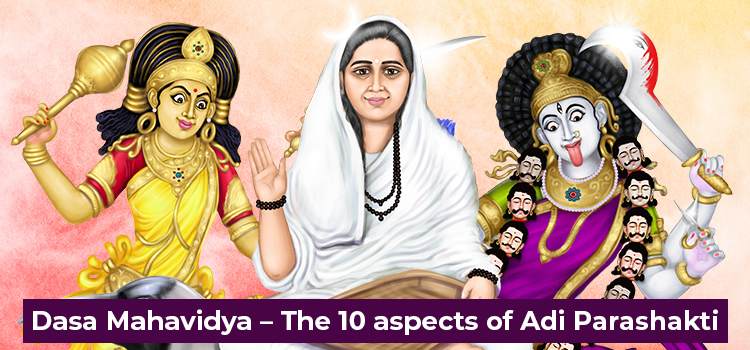Hindus worship the Dasa Mahavidyas or Wisdom Goddesses during the Navratri festival, which honors the Mother Goddess.
Dasa Mahavidyas represent 10 different forms of the Divine Mother (Adi Parashakti). The Sanskrit word ‘Dasa’ means “ten,” Maha means “great,” and Vidya means “knowledge.” It was after a disagreement between
Lord Shiva and Sati, his consort, that the Dasa Mahavidyas were created.

Origin of the Dasa Mahavidyas
Sati was the daughter of Daksha. She married Shiva, but Daksha did not like it. He performed a great yagna and invited all of the gods and goddesses, but not Shiva.
Sati went to the Yajna, though Shiva did not approve of it. He told her that Daksha’s aim was to insult him. Sati became angry as she felt that Shiva was not giving her due respect. After all, she was the Mother of the Universe. So, she assumed the form of the Divine Mother. When this occurred, the oceans raged, and the mountains shook.
Shiva began to tremble and tried to run. But the Divine Mother stopped him. She took ten different forms, which guarded each of the ten directions. So Shiva could not escape.
These ten forms are the Dasa Mahavidyas. Each Goddess has her own story, name, quality, and Mantras.
The Dasa Mahavidyas are:
Kali, Bagalamukhi, Chinnmasta, Bhuvaneshwari, Matangi, Sodasi, Dhumavati, Tripurasundari, Tara, and Bhairavi.
Kali
Sati first took the form of Kali. She looked terrible, and her hair was left loose. Her body was dark, like a storm cloud. She stands on a corpse and wears a garland of skulls and earrings fashioned from the bones of corpses. She has four hands – one holds a skull, and the other a curved and bloody sword. Kali represents the power of consciousness in its highest form.
Kali is the symbol of transformation. She enables the process of transformation from the human to the Divine.
Tara
Tara is worshipped by Hindus and Buddhists. She is the Goddess of compassion and protection. Tara means “star.” One of her names is Samsaratarini meaning “she who takes one across the ocean of worldly existence.”
When the Milky Ocean was being churned, a deadly poison came out of it, and Lord Shiva drank it to save the world. But he fell unconscious due to the effect of the poison. Goddess Durga then appeared as Tara, put Shiva on her lap, and breastfed him. This neutralized the poison. Tara’s maternal instinct makes her very approachable to devotees.
Tripurasundari
Tripurasundari, or Goddess Shodashi, is the most beautiful in all the three worlds. She represents Goddess Parvati. As a form of Mahalakshmi, she represents wealth.
She has four arms, and she holds five arrows of flowers, a goad, a noose, and sugarcane as a bow in them. The noose signifies attachment, the goad signifies repulsion, the sugarcane bow symbolizes the mind, and the arrows are the five senses.
Tripurasundari symbolizes the state of awareness that is characterized as “I am this” (aham idam). She is the beauty that we see all around us.
Bhuvaneshwari
Bhuvaneshvari closely resembles Tripurasundari. Bhuvana means ‘this living world’, and Iswari means ‘female sovereign’.
She is also called Mahamaya, meaning “she whose magical power is great”. Maya is the power to create a magical appearance. Her other names are Sarvarupa (“she whose form is all”) and Vishwarupa (“she whose form is the universe”). All the things we experience in this life form the Divine Mother.
She is red in color and sits on a lotus flower. Her body is resplendent and adorned with jewels. She has a noose (paasa) and a curved sword (ankusham) in two of her hands. The other two show Abhaya mudra and Varada mudra. She dwells in Shiva’s heart.
Chinnamasta
Chinnamasta is also known as Prachanda Chandika. Chinnamasta means “she who is decapitated”. She supposedly cut off her own head.
Once Parvati and her friends, Dakini and Varnini, went to take a bath in the Mandakini River. Her friends felt hungry and asked Parvati for some food. Parvati told them to wait for a while. After a while, her friends again pestered her, reminding her that she was the Mother of the Universe and they were her children who wanted food immediately. Parvati laughed and cut her head with her fingernail. Her blood spurted in three directions. While her friends drank the blood from two of the directions, Parvati drank the blood from the third direction.
Because she cut her own head, she got the name Chinnamasta. She represents the great and rare courage that one needs to make the highest sacrifice.
Bhairavi
Bhairavi means “frightful,”. She is regarded as the Chandi in the Durga Saptashati who kills Chanda and Munda.
Sometimes she sits on a headless corpse in the cremation ground. She has four arms. She holds the sword of knowledge in one hand and the demon’s head that represents the destruction of the ego in another. The other two hands show the Abhaya mudra and the Varada mudra. Often, they also hold a mala, symbolizing devotion, and a book, representing knowledge.
Bhairavi also represents divine wrath, but it is a result of her maternal protectiveness, which seeks to destroy ignorance and all negative forces that keep us in bondage.
Dhumavati
Dhumavati represents the dark side of life. The name means “she who is made of smoke’. Once, Sati swallowed Lord Shiva to satisfy her extreme hunger. Later she disgorged him at his request. Following this, Shiva rejected her and cursed her to assume a widow’s form.
She is associated with a crow which is also her mount. She represents poverty, hunger, thirst, anger, quarrelsomeness, and negativity. She is old and ugly, with sagging breasts and her teeth are crooked or missing. She wears dirty rags.
Dhumavati represents time’s erosive power which steals our loved ones, our strength, vitality, health, and whatever else makes us happy.
Bagalamukhi
She is the “goddess who paralyzes enemies.” In Tantric yoga,
Bagalamukhi has an association with Pranayama.
This Goddess can control and paralyze enemies. Hence, she has the name, Devi of Sthambhana. Bagalamukhi means “the one who checks the mouth.” She can silence speech and still the mind.
Once Ruru, an asura, performed severe penance to win Lord Brahma’s favor. Since Ruru was very powerful, the Gods became afraid and performed Aradhana (propitiation) to yellow water (yellow stands for peace). Pleased with their prayers, the Divine Mother appeared to them as Bagala. Bagala stops all motion, silences the words of evil beings, and also controls their tongues.
Matangi
Matangi is seen as an outcast and impure Goddess. She is a Tantric form of Saraswati, who is the Goddess of knowledge and the arts. They have many traits in common.
Once, Vishnu and his consort, Lakshmi, visited Shiva and Parvati. While dining, the deities dropped some food on the floor. From this food arose a beautiful maiden who asked for their leftovers. The deities gave her the left-overs as prasad. This is the Ucchishta (leftovers) of the deity. Shiva then said that those who recite her Mantra and worship her would have all their material desires satisfied and also triumph over their foes. This maiden’s name is Ucchishta-matangini.
Kamala
Kamala is the tenth of the Mahavidyas. She is often compared with Goddess Lakshmi and is also regarded as Lakshmi. She is also called the Tantric Lakshmi. She offers prosperity and wealth, crops and fertility, and good luck. She is not the wife of any male deity. Other names for her are Rudra (“the howling one”), Ghora or Bhima (“the terrifying one”), or Tamasi (“the dark one”).
By performing Dasa Mahavidya Homa, one can please the ten Wisdom Goddesses and receive manifold blessings.









